|
 Nederlands /
Dutch Nederlands /
Dutch
Spiders
Spiders belong to the class Arachnida. Arthropods such as scorpions, harvestmen, ticks and mites are also among that group.
The rear body (abdomen) is softer than the front. The head and the thorax with legs are fused. This part of the spiders is called prosoma. The head and the thorax with legs are fused. This part of the spiders is called prosoma. They have eight legs. The first pair of legs is usually the longest.
No real antennae only two palps, which are used to sense. The adult males and females have different palps. The palps consist of six segments. The last segment of the adult male is knob-shaped. This bulbous segment stores the sperm packet just before mating. The mating can be dangerous to smaller males. The males of some families are sometimes eaten by the females after mating.
Most of the spiders have eight eyes. But there are also spiders with six eyes. The eyes are not as great.
They are predators. Their method of hunting is different.
Wheel-shaped webs are best known.
Not all spiders us webs to hunt. The bite of spiders in the Netherlands is not dangerous for humans.
|
Family orb-weaver spiders (Araneidae)
These spiders make spiral wheel-shaped webs. People
often ask how
the first thread
is attached.
From a point they release a length of a thread in the wind. They
wait until the
thread is stuck
to another point.
Then the web
can be made.
 |
A picture of young orb-weavers (araneida). Most likely the
European garden spider, because these spiders are the most common in our garden. But that is not certain. Photo 3-6-2013. |
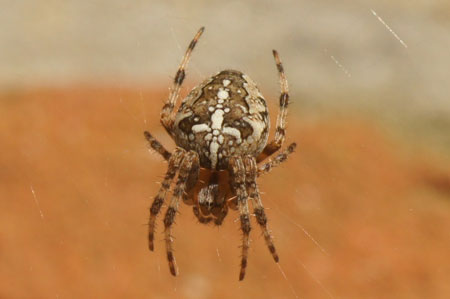 .. ..
 . .
 . .
 European garden spider, diadem
spider, or cross spider (Araneus diadematus). Family orb-weaver
spiders (Araneidae).
European garden spider, diadem
spider, or cross spider (Araneus diadematus). Family orb-weaver
spiders (Araneidae).
At the end of the
summer the garden is full of webs. Many webs are from the European garden
spider. They often span a great distance.
The females are much larger than the males. The mating is risky for the males,
for they can be eaten by the female. When it is freezing the adult spiders die.
The eggs are in cocoons and are deposited in
autumn. This way they hibernate. The young spiders, which hatch in the
spring, release long silken threads to travel on the wind to other
areas. (ballooning)
Cross spider because of the the white dots on its
back forming a cross. Its colour is from light yellow to dark grey.
Length 11-18 mm. Western Europe, parths of North America. Photos 2-10-2010,
15-8-2012. German: Gartenkreuzspinne French: épeire
diadème
|
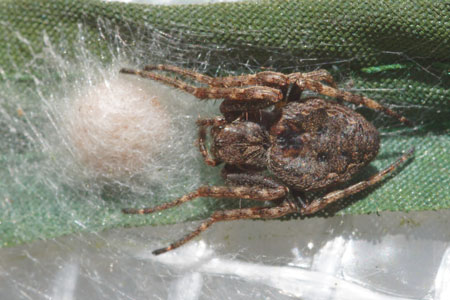 .. ..
 . .
 . .
 Walnut Orb-Weaver Spider
(Nuctenea umbratica). Family orb-weaver
spiders (Araneidae).
Walnut Orb-Weaver Spider
(Nuctenea umbratica). Family orb-weaver
spiders (Araneidae).
Walnut Orb-Weaver Spiders have a flattened body, with a leathery skin. The
colour
ranges from red brown to grey brown. On its body a leaf-like marking. Or
dark like like the spider in the photo bottom left. It
pretended to be dead. It folded its legs around.
The spiders are nocturnal and shy by day. It is hiding under the loose bark of trees. You also
often find the spider around houses. The web looks like the web of a cross spider. From the web the spider
makes a signaling thread to the hiding place. After dusk it sits in the
center of the web. Especially moths should
beware.
Length male 9 mm, female 14 mm. A common spider in Central Europe.
Photos 17-10-2009, 28-5-2010, 23-4-2018. |
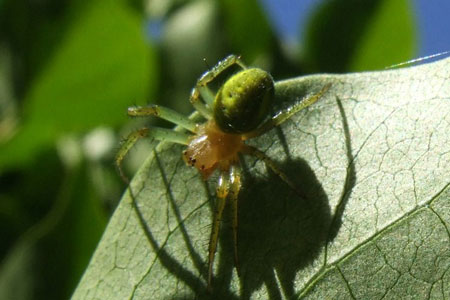 .. ..  . .  Araniella spec. Family orb-weaver spiders (Araneidae).
Araniella spec. Family orb-weaver spiders (Araneidae).
The Araniella cucurbitina and the Araniella
opisthographa are not to distinguish from a photo.
They are recognizable by the yellow-green abdomen.
In July, the eggs are laid in cocoons near the web. The very young spiders
are light in color. In the autumn they are red, brown. A good camouflage
among autumn leaves. They hibernate.
Males 5 mm, females 8 mm.
Small webs. Approximately 10 cm diameter.
Photo 30-5-2009, 28-5-2010, 17-6-2012. German: Kürbisspinnen French: épeire
concombre
 Male. Photo 24-6-2013.
Male. Photo 24-6-2013.  Very young Araniella 7-3-2018.
Very young Araniella 7-3-2018.
|
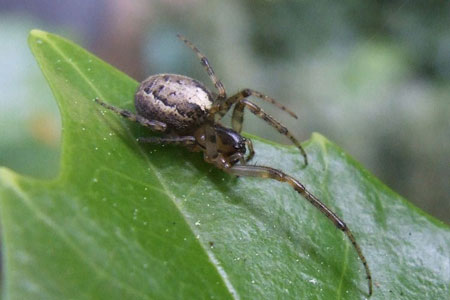 .. ..
 . .
 . .
 Missing sector orb weaver, silver-sided sector spider (Zygiella x-notata),
Family orb-weaver
spiders (Araneidae).
Missing sector orb weaver, silver-sided sector spider (Zygiella x-notata),
Family orb-weaver
spiders (Araneidae).
Grey-brown spiders with a leaf-like marking on the abdomen. At the front of the
abdomen (near the head), it has a light spot.
The web has to the top in the corner two sectors without connecting threads. You can find the webs of
the Zygiella x-notata often in window
frames.
Males up to 7 mm, females up to 11 mm.
The eggs overwinter in a cocoon. The females you can find late in the year.
Europe, parts of Asia, North and South America. Photos 12-9-2009, 17-10-2009,
22-11-2012. |
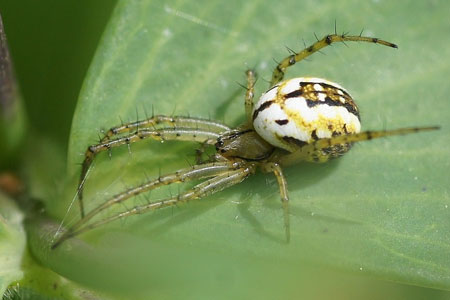 Nymph:
Nymph:  Mangora acalypha. Family orb-weaver
spiders (Araneidae).
Mangora acalypha. Family orb-weaver
spiders (Araneidae).
An easily recognizable spin. By the spots on the body and the black border and center stripe on the
carapace. Webs on bushes and low vegetation.
Male 3-3,5 mm, female 5,5-6 mm.
The Palearctic regions. Photo 13-6-2010, photo nymph 5-4-2018.
German: Streifenkreuzspinne.
|
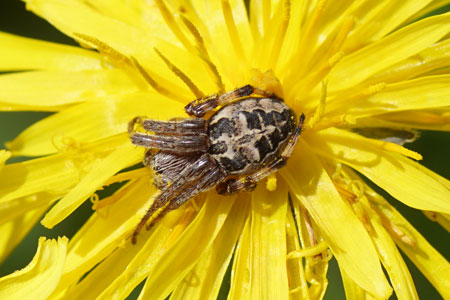 Furrow spider, furrow orb spider, foliate spider (Larinioides cornutus).
Family orb-weaver
spiders (Araneidae). Not in the garden, but near a ditch two kilometers from home.
Furrow spider, furrow orb spider, foliate spider (Larinioides cornutus).
Family orb-weaver
spiders (Araneidae). Not in the garden, but near a ditch two kilometers from home.
Front of the abdomen with a dark, lightly fringed keel spot and a dark, clear V-shape. The
prosoma is grey-brown with light hairs.
Males 6-8 mm, females 10-13 mm. The orb web can be found between reeds and tall grasses or herbs, especially along banks. The Holarctic region. Photo 5-5-2024. German:
Schilfradspinne French: épeire roseaux |
Family Stretch spiders (Tetragnathidae)
Stretch spiders have an elongated body form. They have
long legs. They can camouflage themselves well on a stem or an
elongated leaf. Than they stretch their front legs
forward and the others legs in the other direction.
The web is like a spiral wheel-shaped web, but with a hole in the middle.
 .. ..
 . .
 Stretch spider spec. (Tetragnatha spec.)
Family Stretch spiders (Tetragnathidae)
Stretch spider spec. (Tetragnatha spec.)
Family Stretch spiders (Tetragnathidae)
There are similar species. They are not to identify from a picture.
Early summer I often see them at the pond.
Although I haven't seen it, they can walk over water. Photos
30-6-2012. |
 .. ..
 . .
 . .
 Metellina spec. Family Stretch spiders (Tetragnathidae).
Metellina spec. Family Stretch spiders (Tetragnathidae).
Like the money spiders metellina species have a
tuning fork figure on the carapace.
Metellina mengei Length 5 mm. July - September
or Metellina segmentata. They are very similar. Despite their name they are about the same time of the year.
According Jacomijn Princen: If the ventral hairs (not the bristles) are shorter than the
diameter of the last leg segment of a front leg: It is the M. segmentata. When they are twice as long,
it is is the M. mengei. This feature applies only to males.
Photos 17-5-2009, 12-9-2010, 26-9-2012. German:
Herbstspinnen.

 A young Metellina, nymph. Photos 3-10-2012, 8-4-2018.
A young Metellina, nymph. Photos 3-10-2012, 8-4-2018. |
Family tangle-web spiders, cobweb spiders or comb-footed
spiders (Theridiidae)
They have a bulbous body. Messy webs with sticky threads.
They have rows of tiny bristles on the tip of their
hind legs they use to spread out their silk. Tangle-web spiders (Theridiidae)
have a comb on the underside of the tarsus of leg IV. Tangled nest spiders (Amaurobiidae)
have a comb on the top of the metatars.
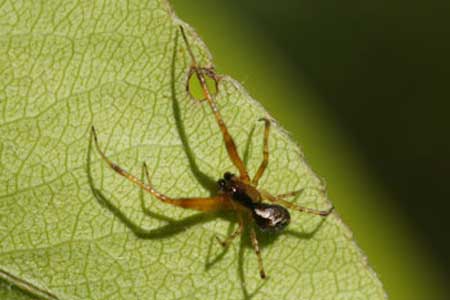 Male
Male  . .
 Female Female
 . .
 . .
 . . 
Anelosimus vittatus, Seycellocesa vittatus. Family tangle-web spiders, cobweb
spiders or comb-footed spiders (Theridiidae).
Length female 3-3.5 mm, male 2.5-3.5 mm.
Low in the trees and bushes and in high vegetation.
Photos female 6-3-2018.
|
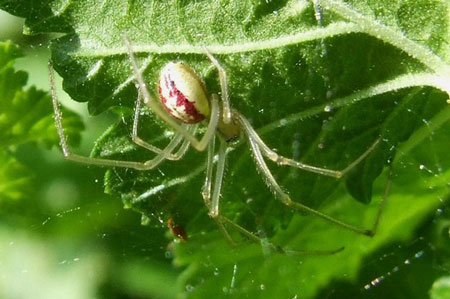 .. ..
 . .
 . .
 Enoplognatha
ovata or Enoplognatha latimana. Family tangle-web spiders, cobweb
spiders or comb-footed spiders (Theridiidae). Enoplognatha
ovata or Enoplognatha latimana. Family tangle-web spiders, cobweb
spiders or comb-footed spiders (Theridiidae).
Two very similar species. The colour may vary. Always two rows of black spots.
The cocoons with eggs are light blue. You can find
them on leaves curled by spinning. Length 3-6 mm.
Photos 27-8-2012, 24-9-2012. Enoplognatha and
a cocoon, with youg spiders and an Ero.
 A
young Enoplofnatha. Foto 16-2-2014. The dark spots are very well visible. A
young Enoplofnatha. Foto 16-2-2014. The dark spots are very well visible. |
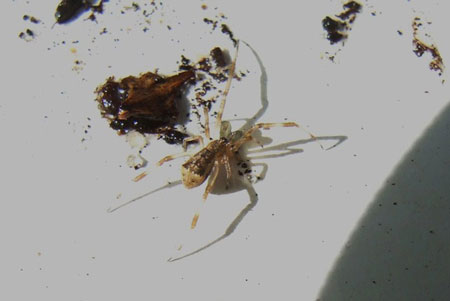 .. ..
 . .
 . .
 Episinus
angulatus. Family tangle-web
spiders, cobweb
spiders or comb-footed spiders (Theridiidae). Episinus
angulatus. Family tangle-web
spiders, cobweb
spiders or comb-footed spiders (Theridiidae).
They can stretch their front legs
forward like Stretch spiders. In 2009 I found this young spider on a flowerpot.
They make their H-shaped web at or near ground level.
The Episinus angulatus has a flat, thin body, but
it broadens a bit near the end. About 5 mm Photos 8-10-2009, 11-10-2010, 30-2-2012, 19-4-2012.
 Now I find every year some spiders of this species.
Now I find every year some spiders of this species. |
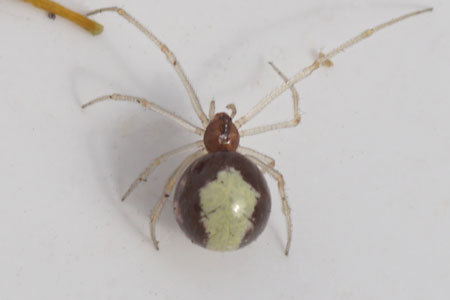 .. ..
 . .
 Neottiura bimaculata. Female. Family
tangle-web spiders, cobweb spiders or comb-footed spiders (Theridiidae). Familie kogelspinnen
(Theridiidae).
Neottiura bimaculata. Female. Family
tangle-web spiders, cobweb spiders or comb-footed spiders (Theridiidae). Familie kogelspinnen
(Theridiidae).
A dark spider with a broad whitish or yellowish stripe. The size of the stripe is
variable, sometimes it is very broad. The females carry their egg sac. Length female 3-3.5 mm, male 2.5-3 mm.
In lower vegetation and bushes. Europe, Asia, North America, North Africa.
Photos 9-6-2018, 11-6-2018.
 4-7-2018 Neottiura bimaculata with egg sack.
(taken in the dunes)
4-7-2018 Neottiura bimaculata with egg sack.
(taken in the dunes)
 29-4-2024 Neottiura bimaculata
male with parasite.
29-4-2024 Neottiura bimaculata
male with parasite. |
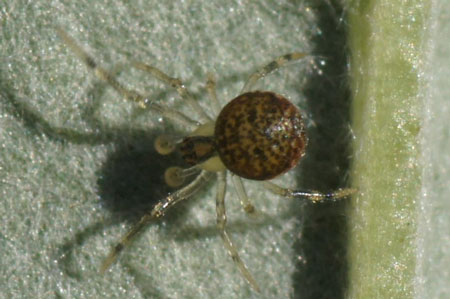 .. ..
 Paidiscura pallens. Young male. Family tangle-web
spiders, cobweb
spiders or comb-footed spiders (Theridiidae). Paidiscura pallens. Young male. Family tangle-web
spiders, cobweb
spiders or comb-footed spiders (Theridiidae).
A tiny, pale yellow spider. The abdomen of the male is dark spotty and of the female pale yellow. Length female 1,25-1,5 mm, male 1.7-1.75 mm. Male april - June. Female throughout the year.
Especially along forest edges under oak leaves.
Photos 11-10-2016.  Female
6-6-2019. Female
6-6-2019.  Female with cocoon (more photos: Waarneming.nl/observation/173990888
) 7-6-2019.
Female with cocoon (more photos: Waarneming.nl/observation/173990888
) 7-6-2019. |
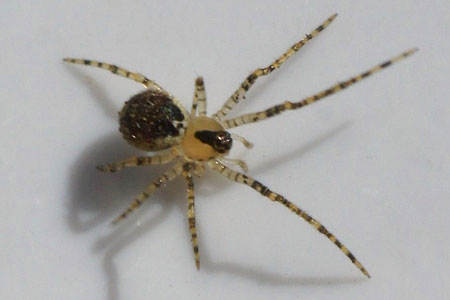 Platnickina
tincta. Family tangle-web
spiders, cobweb
spiders or comb-footed spiders (Theridiidae). Platnickina
tincta. Family tangle-web
spiders, cobweb
spiders or comb-footed spiders (Theridiidae).
Light legs with black rings are striking in this spider. Length 2.5 mm female, male 2.5-3.5 mm.
Most of the year with a peak time from May to July. Usually found on low vegetation,
lower branches of conifers and deciduous trees and shrubs.
Photo 6-3-2017. |
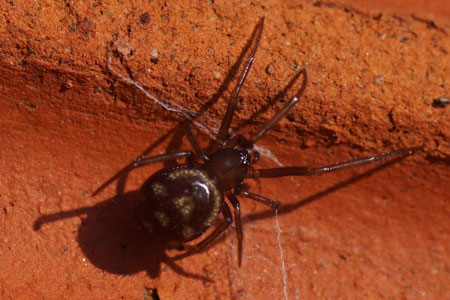 Cupboard spider, dark comb-footed spider, brown house spider, false widow or false black widow
(Steatoda grossa).
Nymph Family tangle-web spiders, cobweb
spiders or comb-footed spiders (Theridiidae).
Cupboard spider, dark comb-footed spider, brown house spider, false widow or false black widow
(Steatoda grossa).
Nymph Family tangle-web spiders, cobweb
spiders or comb-footed spiders (Theridiidae).
Compared to other cobweb
spiders large. Dark colored, coloring ranges from purplish brown to black, with light colored markings.
In houses and gardens. A web against the ground surface.
Adult female 6.5-10 mm, male 4-6 mm. Photo 14-9-2020 Adult spider:
 . .
 5-8-2022
5-8-2022
|
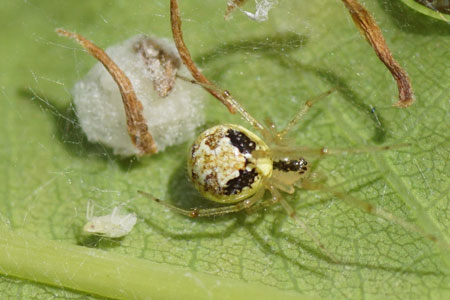 .. ..  Theridion varians. Family tangle-web
spiders, cobweb
spiders or comb-footed spiders (Theridiidae). Theridion varians. Family tangle-web
spiders, cobweb
spiders or comb-footed spiders (Theridiidae).
Not sure, because it is very similar to the Theridion hemerobium and the Theridion
pictum, which occur in more humid biotopes. The abdomen is usually pale green with a variable coloured pattern. From pale red-brown to with a large part of black. Female length 2.5-4 mm, male 2.5-3.5 mm. A peak time is from May to July. In drier needle and deciduous forests. Lives in low vegetation, but also on shrubs and trees. In our garden in a low oak. Europe (up to
Sibiria), North America, North Africa, Turkey, Caucasus, Central Asia and China. Photos 7-7-2019, 9-7-2019. |
Family sheet weavers (from the shape of their webs),
money spiders (Linyphiidae)
sheet webs with criss-cross threads above it to let the insects fall
down in the web. The spider hangs upside down under it.
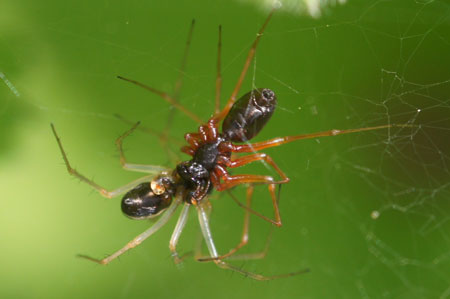 .. ..
 . .
 . .
 . .
 . .
 Linyphia
hortensis. Family sheet weavers,
money spiders (Linyphiidae) Linyphia
hortensis. Family sheet weavers,
money spiders (Linyphiidae)
At first I thought to
Microlinyphia pusilla. But according to Pierre Oger
is Linyphia hortensis most likely. Also because they are found in May in
the garden. In the Netherlands mainly in May - June.
The female is dark and has a white band on the side. On the abdomen are
white spots. These are variable. The males are not similar. They have
narrow abdomen and their legs are brown red. They make their web quite close to the ground.
About 5 mm. Photos May 2010. |
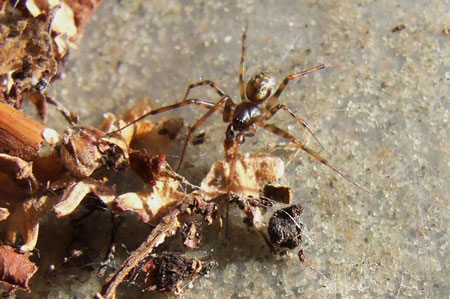 .. ..
 . .  Lepthyphantes
minutus. Genus Lepthyphantes. Family sheet weavers,
money spiders (Linyphiidae). Lepthyphantes
minutus. Genus Lepthyphantes. Family sheet weavers,
money spiders (Linyphiidae).
In any case Lepthyphantes. The species is not
certain. Recognizable by the dark carapace and striped legs.
You can find it near tree trunks I found this spider in October under a bag
of sand.
Lepthyphantes are small spiders. This is a larger species. But still small.
Length 3-4 mm.
Photos 18-10-2009. |
 .. ..
 Microneta viaria. Family sheet weavers,
money spiders (Linyphiidae). Microneta viaria. Family sheet weavers,
money spiders (Linyphiidae).
A red-brown prosoma and a black-brown abdomen. Solid yellow-brown legs.
In moderately moist leaf waste under trees and shrubs.
Body length 2.1-3 mm.
Adult spiders can be found throughout the year, but in the Netherlands most observations are in autumn, winter and spring.
Palearctic and Nearctic region. Photos 8-2-2018. Male. |
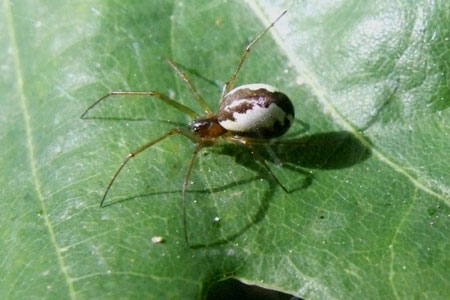 .. ..
 Platform hammock-spider
(Neriene peltata). Family sheet weavers,
money spiders (Linyphiidae). Platform hammock-spider
(Neriene peltata). Family sheet weavers,
money spiders (Linyphiidae).
The back is white with a dark brown central stripe.
The abdomen is striped brown and white.
Body length about 5 mm. Male: April - July. Female: April - September.
Photos 2-6-2009.
German: Waldbaldachinspinne. |
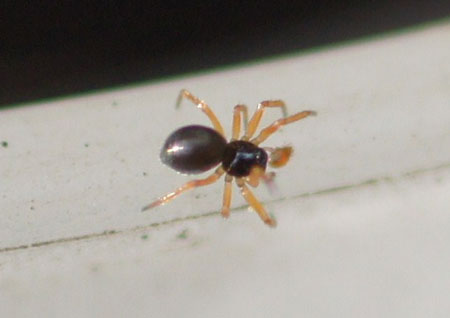 .. ..
 . .
 Dwarfspider (Erigonidae) Family dwarfspiders
(Erigonidae) Also called subfamily of sheet weavers,
money spiders (Linyphiidae). Dwarfspider (Erigonidae) Family dwarfspiders
(Erigonidae) Also called subfamily of sheet weavers,
money spiders (Linyphiidae).
This spider was about two mm. There are many species. From a photograph, they are not to
determine.
The dwarfspider from 2011 was a little larger. It is an other species.
Photos 15-11-2010, 25-11-2011. |
Familie Kaardertjes (Dictynidae)
They create a tangle of silken fibers.
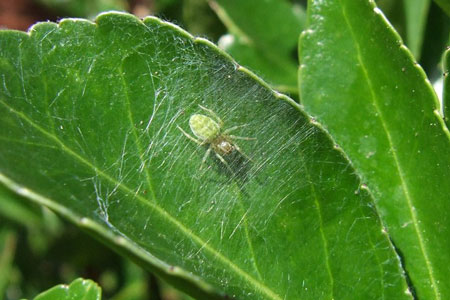 .. ..
 . .
 Nigma
walckenaeri. Family Dictynidae. Nigma
walckenaeri. Family Dictynidae.
This green spider lives on leaves and is well
camouflaged. The male has a
reddish brown carapace.
As you can see on the photos it makes very fine cobwebs. From the curled
leaves it makes a shelter by cobwebs.
The male stays with the female and there is no no danger, it is eaten by the
female, like most other spiders. But when it dies, it is still eaten.
Length 3 - 5 mm.
Adults in August - October. Photos 18-10-2009,
3-10-2012, 19-10-2012. |
Family Vibrating Spiders (Pholcidae)
Spiders with a small body and very long legs. They make messy, irregular,
tangled webs.
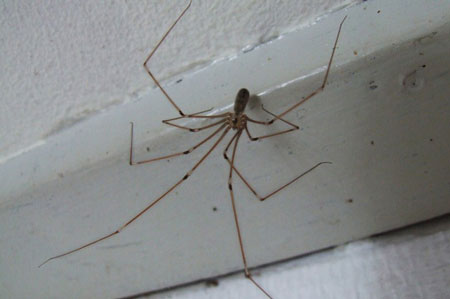 .. ..
 Daddy-long-legs spider, cellar
spider or skull spider, vibrating
spider, house spider (Pholcus
phalangioides). Family Pholcidae. Daddy-long-legs spider, cellar
spider or skull spider, vibrating
spider, house spider (Pholcus
phalangioides). Family Pholcidae.
The spider has got its name vibration spider, because it is shaking when
it is threatened.
Just like in our house you can find this spider in most houses and barns. Often in dark places.
They make a rather messy web. Often near the ceiling. When the web is
dirty, they make a new one. They don't eat their own web like many other
spiders. My wife is not very happy with these webs.
The spider throws tough web material over the victim in the web until it is
harmless. The eggs are held together with a few wires. The female hold the eggs in
her pedipalps.
Body length females: about 9 mm. Males are slighty
smaller. Photos 8-10-2009,
6-11-2012. German: Große Zitterspinne French: Pholque
phalangide. |
Family tangled nest spiders, night spiders,
hacklemesh weavers (Amaurobiidae)
Night spiders because they are active at night.
They make wooly combed catching silk. It is a not sticking, messy web, but
when the victim in the web tries to free itself, it becomes even
more tangled into the stretching, wooly silk. With a
comb on the rear legs the spider comb the silk wooly. Tangled nest
spiders (Amaurobiidae) have a comb on the top of the metatars. Tangle-web spiders
(Theridiidae)
have a comb on the underside of the tarsus of leg IV.
 .. ..
 Window spider, Amaurobius fenestralis
or Amaurobius similis. Family tangled nest spiders, night spiders,
hacklemesh weavers (Amaurobiidae). Window spider, Amaurobius fenestralis
or Amaurobius similis. Family tangled nest spiders, night spiders,
hacklemesh weavers (Amaurobiidae).
Both species are quite similar. You can find them in the house. But usually
they are on outside walls near windows, but
also under bark and stones.
On the abdomen, the window spider has some V-shaped spots.
The spider in the pictures on the left is a man. I found them under the lid of a garbage can.
Length 7 - 12 mm.

 Female. Photos 9-10-2012. 30-4-2010.
Female. Photos 9-10-2012. 30-4-2010. |
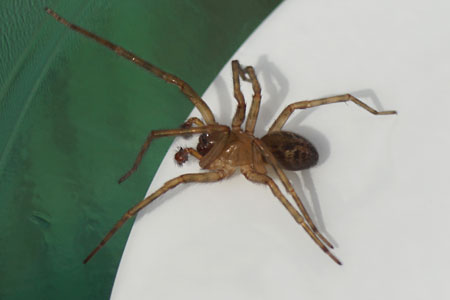 .. ..
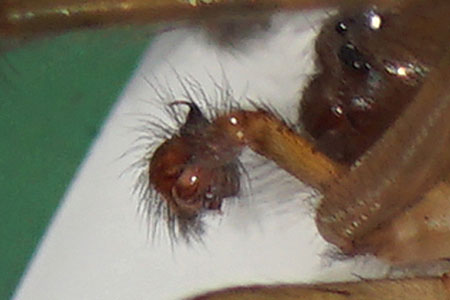
Amaurobius
similis. Family tangled nest spiders, night spiders,
hacklemesh weavers (Amaurobiidae). male
Male Amaurobius similis has thin, strongly curved inner tibial apophysis ("hook"). Amaurobius fenestralis has a palp with a wide and (viewed from above) almost straight inner tibial apophysis. Information on Waarneming
in Dutch. The males can be identified in this way.
|
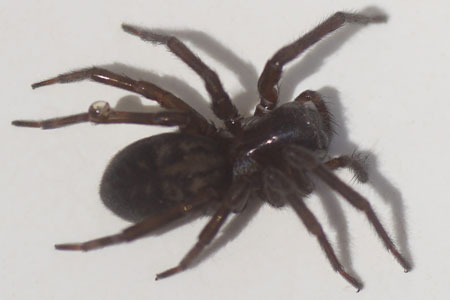 .. ..
 . .
 . .
 Black lace-weaver(Amaurobius ferox). Female. Family tangled nest spiders, night spiders,
hacklemesh weavers (Amaurobiidae).
Black lace-weaver(Amaurobius ferox). Female. Family tangled nest spiders, night spiders,
hacklemesh weavers (Amaurobiidae).
Often in cellars, under stones and dead wood. Dark brownish red, blackish. Back body hairy, dark with lighter
markings, which are clearer in the male. Female length 11-16 mm, male 11-12 mm. Photos 8-4-2019.
|
Family funnel-web spiders(Agelenidae)
In the Netherlands, the family consists of the genus Agelena, Allagelena, Eratigena, Histopona, Inermocoelotes, Malthonica,
Tegenaria and Textrix.
The genus Tegenaria has recently been split: Tegenaria species have striped legs, Eratigena species have normal legs. Furthermore, they are very difficult to identify.
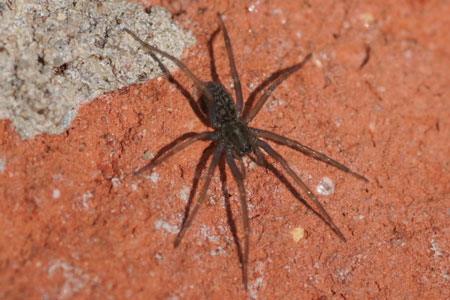 A young jonge Housespider spec (Tegenaria or Eratigena
spec.). Family funnel-web spiders (Agelenidae)
A young jonge Housespider spec (Tegenaria or Eratigena
spec.). Family funnel-web spiders (Agelenidae)
Stripes on the legs aren't clear yet. Photo 25-4-2011
|
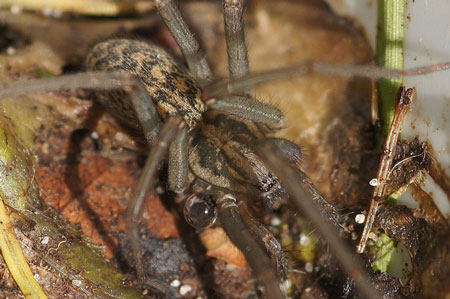 .. ..
 . .  .
.  Giant house spider,
Dust Spider, Dustbunny Spider (Now
Eratigena atrica, formely Tegenaria atrica). Family funnel-web spiders
(Agelenidae) Giant house spider,
Dust Spider, Dustbunny Spider (Now
Eratigena atrica, formely Tegenaria atrica). Family funnel-web spiders
(Agelenidae)
The giant house spider therefore has no markings on its gray-brown legs. It lives in and near houses. In other countries it lives near rock walls.
They create a horizontal, dense web that ends in a funnel. A kind of living tube. During the day he hides. At night it sits in its web. The eggs are laid in April. Young giant house spiders appear in May. The males do not grow old. The females, however, can live up to six years. Males 15 mm, females 18 mm. Common in Europe. Photos 3-7-2011. |
Family six-eyed spiders (Segestriidae).
Spiders with six eyes instead of eight eyes like most spiders.
 .. ..
 Segestria bavarica. Family six-eyed spiders (Segestriidae).
Segestria bavarica. Family six-eyed spiders (Segestriidae).
I found it against the wall of the kitchen. A hairy, dark brown spider. The abdomen lighter in the middle with dark spots and with a light central line through the rear spots.
It lives in cracks in walls, rocks and bark.
It makes a tubular shelter with signal wires, through which it notices and catches insects in the dark. The eggs are
layed in the shelter and guarded. Males 9-11 mm females 10-13 mm. Europe. Photos 29-4-2019.
|
These spiders don't use webs to capture prey.
Family Spitting
spiders (Scytodidae) and also belongs to the
family of six eyed spiders. (Haplogynae)
They spit a poisonous silk in a zig-zaggy pattern at their prey. The prey is stuck on the surface.
Distance up to about 2 cm. In the Netherlands Scytodes thoracia is the only
species.
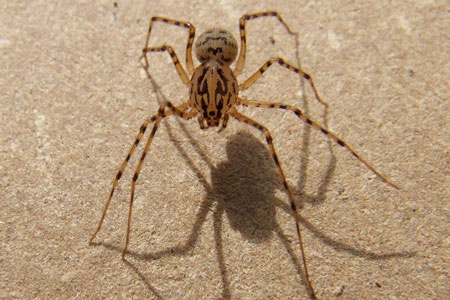 .. ..
 .
Spitting Spider (Scytodes
thoracica) Family
Spitting spiders (Scytodidae). .
Spitting Spider (Scytodes
thoracica) Family
Spitting spiders (Scytodidae).
A light brown spider with a flecked pattern of dark spots.
The spider has long legs with dark rings. The thorax is larger than the abdomen. Unlike most spiders
with eight eyes the Spitting spider has six eyes.
The silk, they spit is poisonous. In the head-thorax are silk glands, which are connected to venom glands. They also have silk glands in the body behind.
The females carry the egg mass under their body. In the Netherlands they mainly are found in the houses, for the winters are too cold for them.
Originally they live in southern Europe.
Length 3-6 mm.
Photos 27-3-2009, 01-10-2011. German:
Speispinne, Leimschleuderspinne. |
Family wolf spiders (Lycosidae)
Some species are chasing their prey (small distances). Other wolfspiders wait
for a prey (in a burrow). The females carry their egg sacs by attaching them to their spinnerets.
Burrowing species hide the cocoon in the ground. When the young leave the sac, they stay on the abdomen of mother.
 .. ..
 . .
 Common fox-spider
(Alopecosa pulverulenta). Family wolf spiders (Lycosidae). Common fox-spider
(Alopecosa pulverulenta). Family wolf spiders (Lycosidae).
A dark reddish-brown spider. The prosoma with a wide paler middle band. The abdomen with a lancet-shaped
pale brown middle band with a lancet-shaped dark part in the middle. Other spiders from this genus in the Netherlands are
Alopecosa cuneata), Alopecosa cursor, Alopecosa fabrilis, Alopecosa
trabalis. Length male:
about 7 mm, female: about 7-10 mm.
The females dig a burrow where they guard their egg sack.
Photos 29-3-2019. |
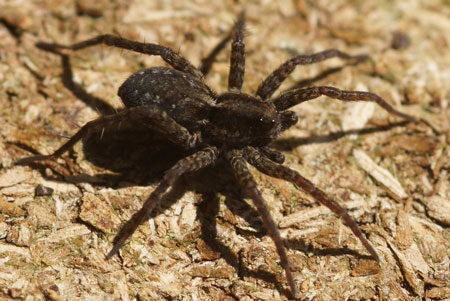 .. ..
 . .  Wolf spider spec.
(Pardosa spec.) Family wolf spiders (Lycosidae). Wolf spider spec.
(Pardosa spec.) Family wolf spiders (Lycosidae).
The species can't be determined from a photo. They are walking around in our garden in search of victims. Therefore they
have a good vision. Photos 27-3-2011, 22-5-2010.
The females carry their egg sacs by attaching them to their spinnerets.
When the young leave the sac, they stay on the abdomen of mother. German: Wolfspinne
 With young spiders on the back. Photo 6-8-2010.
With young spiders on the back. Photo 6-8-2010.
 Sometimes
a wolf spider make a mistake. Here a female has a faded woodlouse as a cocoon.
Photo 30-8-2010. Sometimes
a wolf spider make a mistake. Here a female has a faded woodlouse as a cocoon.
Photo 30-8-2010. |
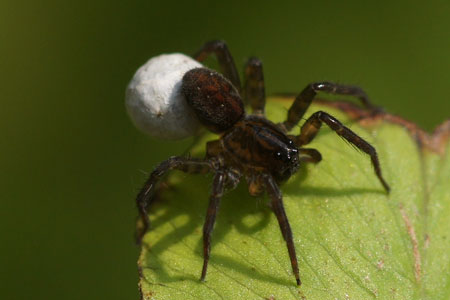 .. ..
 Pirate wolf spider spec.
(Pirata spec.)
Family wolf spiders (Lycosidae).
Pirate wolf spider spec.
(Pirata spec.)
Family wolf spiders (Lycosidae).
This
spider was
among the plants,
I
took
away from
the
pond.
The
name "pirate"
it owes
to
the fact that
he lives
in
the
water.
They
can walk
on water.
There are similar species.
Parate wolf spiders have a
tuning fork figure on the carapace.
The
cocoon,
you
see here is
waterproof.
Photo 28-7-2011.
German: Wasserjäger
was
among the plants,
I
took
away from
the
pond.
The
name "pirate"
it owes
to
the fact that
he lives
in
the
water.
They
can walk
on water.
There are similar species.
Parate wolf spiders have a
tuning fork figure on the carapace. The
cocoon,
you
see here is
waterproof.
Photo 28-7-2011. German: Wasserjäger . |
 .. ..  . .  Trochosa territcola or Trochosa
spinipalpis. Family wolf spiders (Lycosidae). Genus Trochosa. Trochosa territcola or Trochosa
spinipalpis. Family wolf spiders (Lycosidae). Genus Trochosa.
In Europe there are four species. Trochosa terricola and Trochosa spinipalpis look very much alike. They hunt at night. By day they hide. This female, however, was in the sun on a leaf.
Photos 18-4-2010. |
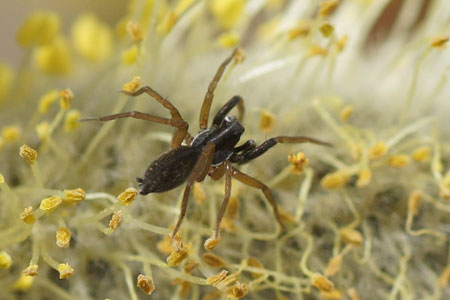 .. ..
 Aulonia
albimana. Family wolf spiders (Lycosidae). Not in the garden
but in the dunes 4 km from our house. Aulonia
albimana. Family wolf spiders (Lycosidae). Not in the garden
but in the dunes 4 km from our house.
A small wolf spider. Here it is walking on the flower of a willow. The front part is dark brown to black with a thin white border around it. The abdomen is dark brown, dark gray. Brown legs, only the upper part of the front legs is black.
The middle segments of the black pedipalps of both the male and the female are
white. (not shown in the picture)
Unlike the most wolf spiders it makes a web. It is a funnel web near the ground. But they also
walk around. The spider in the picture was somewhat higher.
It is found in dry areas with low plants, in the Netherlands in the dunes. In the rest of the Netherlands,
it is quite rare.
Length to 4.5 mm. Photos 21-4-2013. Europe. |
Family Nursery web spiders (Pisauridae)
Nursery web spiders make egg sacs, which they first carry under the body. When
the eggs are about to hatch, the cocoon will be attached to a plant. Therefore
the female spider will build a kind of woven tent. A nursery tent. That's why they got the name nursery web spider. In the Netherlands there are two
genera. Pisaura and Dolomedes.
The six eyes of a nursery spider have more or less the same size. The wolf
spiders also have six eyes, but have two prominent eyes.
Family Cell spiders, woodlouse
hunters (Dysderidae)
Family Sac Spiders (Clubionidae)
Usually without much colour and therefore they are difficult to
determine. They hunt at night.
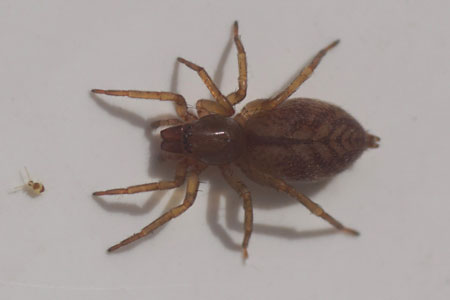 .. ..
 Clubiona comta. Family
Sac Spiders (Clubionidae). Female.
Clubiona comta. Family
Sac Spiders (Clubionidae). Female.
Looks like the larger Clubiona corticalis. Abdomen with a striking pattern. Female 4-6 mm, male 3-5 mm. Photos: 7-5-2019. |
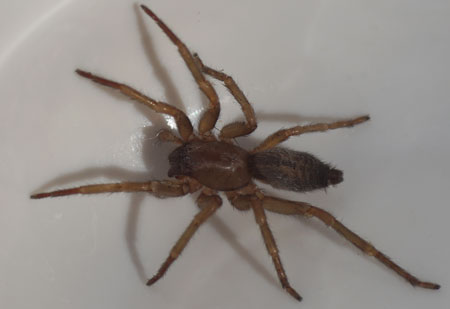 Clubiona corticalis. Family
Sac Spiders (Clubionidae). Female.
Clubiona corticalis. Family
Sac Spiders (Clubionidae). Female.
So looks like the smaller Clubiona comta with a patterned body. I found this spider on the counter at home. Looking at the lean abdomen, there was little food. Female 7-11 mm, male 6-10 mm. Photos: 12-11-2019. |
Family Ground spiders (Gnaphosidae).
This family closely related to Clubionidae.
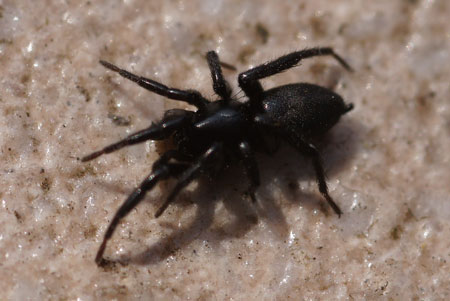 Ground spider spec. (Gnaphosidae).
Ground spider spec. (Gnaphosidae).
There are several dark species, which are difficult to
identify. Zelotes is possible. But it is not certain.
They hunt at night and hide during the day. As a shelter, they weave a silk
bag. This spider was a little confused, because it walked on the terrace by
day, Length about 8 mm. Photo 18-4-2011. |
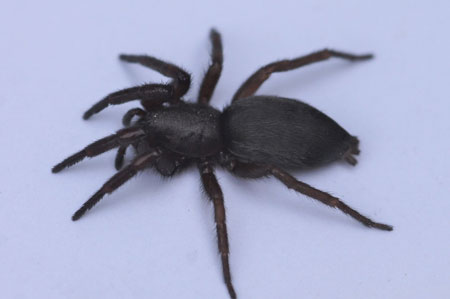 Scotophaeus. Family Ground spiders (Gnaphosidae).
On the basis of size probably Scotophaeus scutulatus.
Scotophaeus. Family Ground spiders (Gnaphosidae).
On the basis of size probably Scotophaeus scutulatus.
Scotophaeus scutulatus (Female 8-16 mm, male 7-11mm) and Scotophaeus blackwalli
(Female 8-16 mm, male 7-11 mm) can't be separated from a photograph like this. I found this spider in the sink in the kitchen.
Photo 13-5-2018. |
Family
Buzzing spiders (Anyphaenidae)
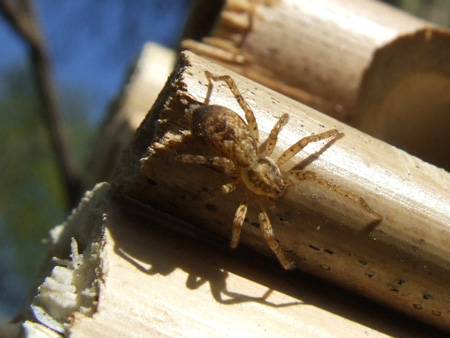 Buzzing spider (Anyphaena
accentuata). Buzzing spiders (Anyphaenidae). In the Netherlands it is the singel species of the buzzing spiders. At night the buzzing spider hunts on the leaves of bushes and trees. On this photo the spider is sitting on the bamboo, which is designed for masonry bees to make nests in it. I am not really happy. Buzzing spider (Anyphaena
accentuata). Buzzing spiders (Anyphaenidae). In the Netherlands it is the singel species of the buzzing spiders. At night the buzzing spider hunts on the leaves of bushes and trees. On this photo the spider is sitting on the bamboo, which is designed for masonry bees to make nests in it. I am not really happy.
Under the leaves you can find cocoons with eggs, which are guarded by the females. The males are able to produce audible sounds by vibrating the abdomen against the leaves (for the females).
From light brown to grayish brown. They can be identified by the triangular dark spots on the rear body. And by the dark lateral bands on the carapace with light spots.
In winter they sit under the bark of dead trees. Length 4-8 mm. Europe, Central Asia. Photos 18-4-2010.
|
Family crabspiders (Thomisidae)
Like crabs crabspiders have a flat body and powerful frontlegs and they are able
to move sideways. They are oft sitting among or on leaves or flowers.
 .. ..
 . .  Diaea
dorsata. Family
crabspiders (Thomisidae). Diaea
dorsata. Family
crabspiders (Thomisidae).
To recognize by the green carapace and legs. A
brown with yellow abdomen.
Males 4 mm, 6 mm females.
This spider was missing a leg, but it did not bother. If it is not an
adult, it gets a new leg after molting. In dangerous situations, these
spiders and many other spiders are able to drop a leg. German: Grüne
Krabbenspinne, Grünbraune Krabbenspinne.
 Crabspiders don't make a web, but they use spider silk as security thread.
gh
the air) Photo: 21-10-09
Crabspiders don't make a web, but they use spider silk as security thread.
gh
the air) Photo: 21-10-09
 The male Diaea dorsata has
very long legs. Photo 16-5-2010.
The male Diaea dorsata has
very long legs. Photo 16-5-2010. |
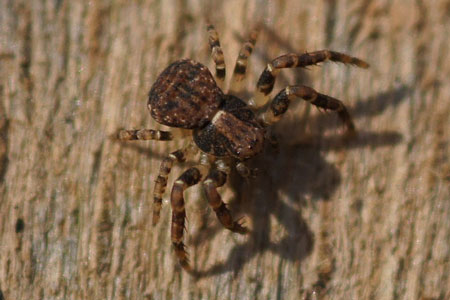 Leaflitter Crab Spider
(Ozyptila praticola). Family
crabspiders (Thomisidae). Leaflitter Crab Spider
(Ozyptila praticola). Family
crabspiders (Thomisidae).
They
can be found in the bushes and the lower part of trees. The female guards her cocoon with eggs.
There
are twelve species Known in Europe. All
very small spiders. Length 3-4 mm. Photo 15-11-2010. |
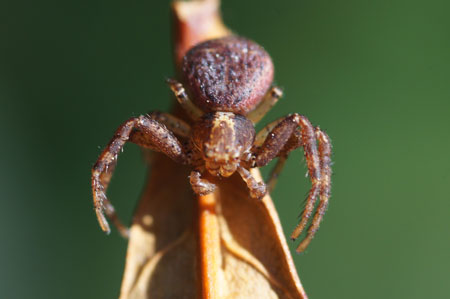 .. ..
 . .
 Xysticus
lanio. Family
crabspiders (Thomisidae). Xysticus
lanio. Family
crabspiders (Thomisidae).
Male 4 - 6 mm. Female 6 -7 mm. Europe. Photos 11-10-2010. |


 Mother love. When I pruned the Euonymus (bush) on 24-5-2011, I saw a Xysticus lanio sitting on her nest. I folded the leaves a bit and took some pictures. I did not prune this twig. Every few days, I was looking at the spider. I always found her at her nest. Almost two months later (17-7-2011) the young spiders appeared. Mother was still present. What is nature special. Mother love. When I pruned the Euonymus (bush) on 24-5-2011, I saw a Xysticus lanio sitting on her nest. I folded the leaves a bit and took some pictures. I did not prune this twig. Every few days, I was looking at the spider. I always found her at her nest. Almost two months later (17-7-2011) the young spiders appeared. Mother was still present. What is nature special. |
Family Running
Crab Spiders (Philodromidae)
Running crab spiders closely resemble crab spiders (Thomisidae), but their
second set of legs are the longest. They chase for prey. Crab spiders wait for
prey. Both species are able
to move sideways.
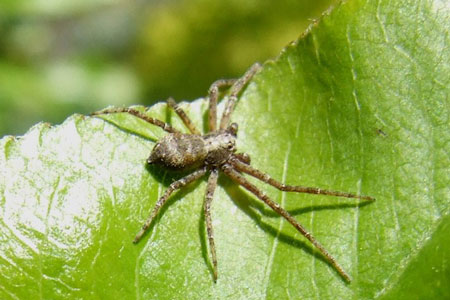 .. ..
 . .  Philodromus spec. Family Running
Crab Spiders (Philodromidae). Philodromus spec. Family Running
Crab Spiders (Philodromidae).
What species it is, I can't say. A microscope is required!! It is able to run away sideways.
You often can see them with spread legs close to a leaf.
Photos 29-4-2009, 6-6-2009, 13-6-2009. German:
Laufspinnen. |
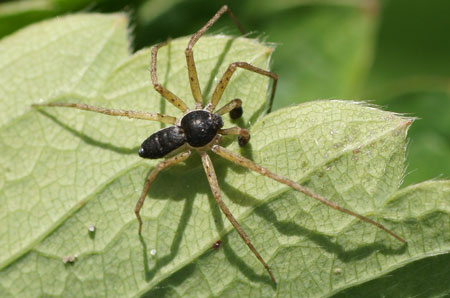 Philodromus
dispar. Family Running
Crab Spiders (Philodromidae). Philodromus
dispar. Family Running
Crab Spiders (Philodromidae).
This is the male. The male Philodromus dispar is
black or dark brown with white edges.
The female is
variable in colour.
About 5 mm.
Photo: 5-5-2012.
 Female Philodromus
dispar 15-11-2010.
Female Philodromus
dispar 15-11-2010. |
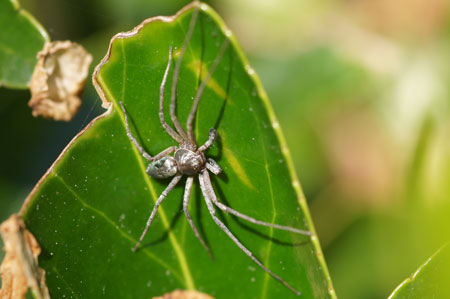 .. ..  Darker: Philodromus
aureolus. Family Running
Crab Spiders (Philodromidae).
Darker: Philodromus
aureolus. Family Running
Crab Spiders (Philodromidae).
This is a male. Thin palps. Males have a metallic sheen. This
spider have a grey colour. Often it is grey with a purple sheen. Females and
young spiders have no metallic sheen (Tan - brown).
They
can be confused with Philodromus
cespitum and Philodromus buxi.
May-August.
Males: 4-5 mm. Females: 4-7 mm.
The young spiders overwinter. Photos 28-5-2010, 30-5-2010. |
 Rhysodromus
histrio. Family Running
Crab Spiders (Philodromidae). Not in the gartden but
in the dunes about 2 km from our house. Rhysodromus
histrio. Family Running
Crab Spiders (Philodromidae). Not in the gartden but
in the dunes about 2 km from our house.
A very contrasting brown and white drawing.
Length 5-7 mm. Photo 3-9-2023. |
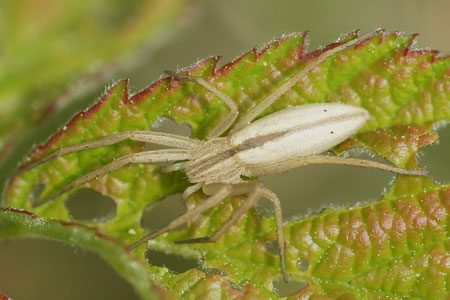 Tibellus oblongus or Tibellus
maritimus.
Not in the gartden but
in the dunes about 4 km from our house. Tibellus oblongus or Tibellus
maritimus.
Not in the gartden but
in the dunes about 4 km from our house.
A light brown or pale yellow spider. It is elongated and slender. From the head runs a brown stripe on the midline of the
abdomen. On the abdomen two small dark spots. The two species
are very similar. Length 7-10 mm. Photo 17-6-2013. |
Family jumping spiders (Salticidae)
Jumping spiders can jump from place to place, secured by a silk tether.
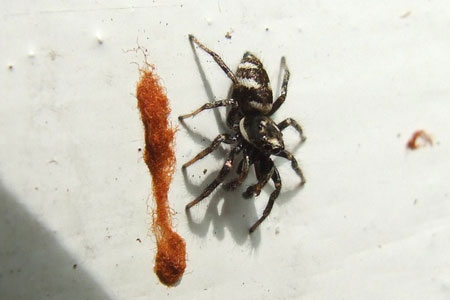 .. ..  . .
 . .  Zebra spider
(Salticus scenicus). Subfamily Salticinae. Family jumping spiders (Salticidae). Zebra spider
(Salticus scenicus). Subfamily Salticinae. Family jumping spiders (Salticidae).
Zebra spiders are like the zebras black with white stripes of hairs. You can find it outside on the house walls in the sunshine. This spider can jump very well.
The four pairs of eyes are striking. In front of the head are two large and two small eyes. Above, it has two small eyes. They therefore have a good vision a very wide field of view.
In the Netherlands there are two other species. Namely Salticus cingulatus and Zebra Salticus nose.
They use a small white silk sac for hiding. The eggs are also laid in this sac. The adult spider
overwinters. Length 5-7 mm. Widespread throughout Europe, northern Asia and North America. Photos 30-4-2010 / 16-3-2011. German:
Zebraspringspinne.
French: Saltique chevronné. |
 .. ..
 Heliophanus spec. Subfamily
Heliophaninae. Family
jumping spiders (Salticidae). Heliophanus spec. Subfamily
Heliophaninae. Family
jumping spiders (Salticidae).
A jumping spider. There are some similar
Heliophanus species in the Netherlands. A nice
small spider. I often see it early summer in the garden. Similar species:
Heliophanus cupreus,
Heliophanus flavipes. Photos 29-5-2010. |
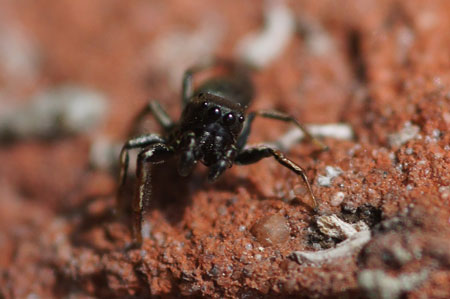 .. ..
 Heliophanus
cupreus. Subfamily Heliophaninae. Family
jumping spiders (Salticidae). Heliophanus
cupreus. Subfamily Heliophaninae. Family
jumping spiders (Salticidae).
In picture the left palp has a small circular hook.
You have to look very well. When you can't find the hook it is Heliophanus
spec. So it is very important, when you want to find the right name. (Thanks
Willem Boomkens). Palearctic. Photos 2-6-2011. |
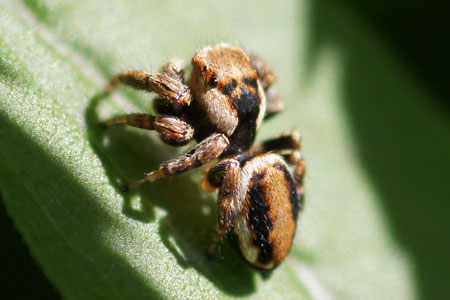 .. ..
 . .
 . .
 Evarcha
falcata. Subfamily
Plexippinae. Family
jumping spiders (Salticidae). Evarcha
falcata. Subfamily
Plexippinae. Family
jumping spiders (Salticidae).
The male is brown. The prosoma with a black rear part and whitish side. The abdomen is light brown with a black band on the side and a white border below.
The female is less variegated. The prosoma is black with brown hairs. A red-brown, gray-brown abdomen with white hairs on the front.
Length male 5 mm. Length female about 7
mm. Palearctic. Photos 14-8-2010, 26-9-2010.
 Female 29-4-2018.
Female 29-4-2018. |
 .. ..
 . .
 . .  Fencepost jumping spider, Marpissa muscosa. Family
jumping spiders (Salticidae).
Fencepost jumping spider, Marpissa muscosa. Family
jumping spiders (Salticidae).
It is a large jumping spider.
In the Netherlands it is a widespread spider.
Mostly on trees. But they also can be found on wooden posts and wooden walls. They are well camouflaged with dark brown markings on the light brown surface.
Photos 24-4-2011.
German: Rindenspringspinne
 female Photo 15-5-2011.
female Photo 15-5-2011.  Nymph 5-4-2014.
Nymph 5-4-2014. |
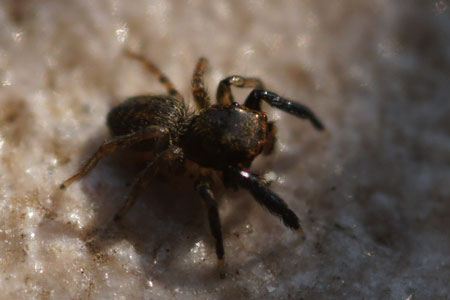 .. ..
 . .  Euophrys
frontalis. Subfamily Euophryinae. Family
jumping spiders (Salticidae). Euophrys
frontalis. Subfamily Euophryinae. Family
jumping spiders (Salticidae).
Compared to the Marpissa muscosa the Euophrys
frontalis is a tiny jumping spider. Around the eyes are red rings. The color is variable. There are light and dark
spiders. The front legs are black. Male 2-3 mm.
Female 3-4 mm. Palearctic. Photo 21-5-2011. |
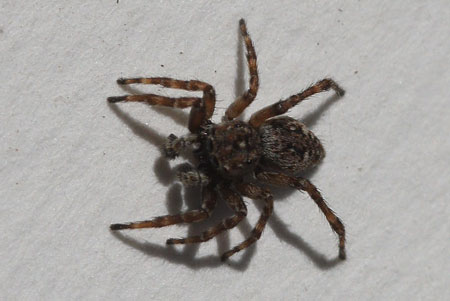 .. ..
 . .
 . .
 Sittipub pubescens, synonym Sitticus
pubescens. Subfamily Sitticinae. Family
jumping spiders (Salticidae). Sittipub pubescens, synonym Sitticus
pubescens. Subfamily Sitticinae. Family
jumping spiders (Salticidae).
You can find it near the house on walls, on the trunk of trees and rocks (not in the Netherlands of course). This male was walking on the tiles of the terrace.
Male
4 mm. Female 4-5 mm. Europe, United States. Photos 3-6-2011, 1-7-2017. German:
Vierpunktspringspinnen. |
Family Pirate spiders (Mimetidae)
In the Netherlands and in the surrounding countries you have of this family only the genus
Ero. In the Netherlands there are four
species: Ero
aphana, Ero
cambridgei, Ero
furcata, Ero
tuberculata.
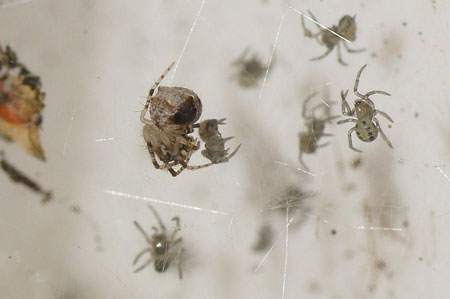 .. ..
 . .
 . .
 Ero spec. Genus Ero. Family Pirate spiders
(Mimetidae).
Ero spec. Genus Ero. Family Pirate spiders
(Mimetidae).
Spiders can attack each other. There is even a
specialized family
spiders. Namely the Pirate spiders, Mimetidae.
The ero don't spin a web.
They bite a spider in its own web mostly in its legs with a
quickly paralyzing venom. It's a small spider from 2 to 4 mm.
This is the Ero aphana or the Ero tuberculata. I saw the Ero after I had photographed
an Enoplognatha nest. Mother Enoplognatha guarded the nest but did not see the
ero. She wasn't attacked by the ero.
The eggs of an ero are laid in a cocoon surrounded with a wiry silk and is
hanging by a silken thread.
Photos 24-9-2012. Photo cocoon 21-7-2011. |
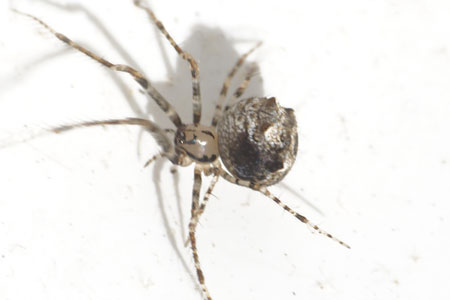 Ero aphana. Genus Ero. Family Pirate spiders
(Mimetidae).
Ero aphana. Genus Ero. Family Pirate spiders
(Mimetidae).
The prosoma is pale yellow-brown with a dark edge, a dark center line and two shorter longitudinal stripes behind the side eyes.
Abdomen with four equally large tubercles. In the Ero tuberculata the front pair of
tubercles is larger than the rear pair.
Legs with pale and dark rings.
Male 2,4-2,6 mm. Female 2,5-3,3mm.
Photo 11-6-2018.
|
 .. ..
 . .  Ero furcata or Ero cambridgei. Genus
Ero. Family Pirate spiders (Mimetidae). Ero furcata or Ero cambridgei. Genus
Ero. Family Pirate spiders (Mimetidae).
Recognizable by the light brown prosoma with a dark edge, a dark stripe behind the eyes and a dark center line. The
abdomen has two small nodules. Legs with brown and white rings.
Male 2,3-2,75 mm. Female 2.5-3.25 mm. Photos 13-3-2018. |
Subpage other Arthropods (Arachnida) harvestmen, pseudoscorpions,
mites and ticks.
I want to thank everyone, who has helped me (waarneming.nl)
to identify.
Nederlands /
Dutch
 
|
